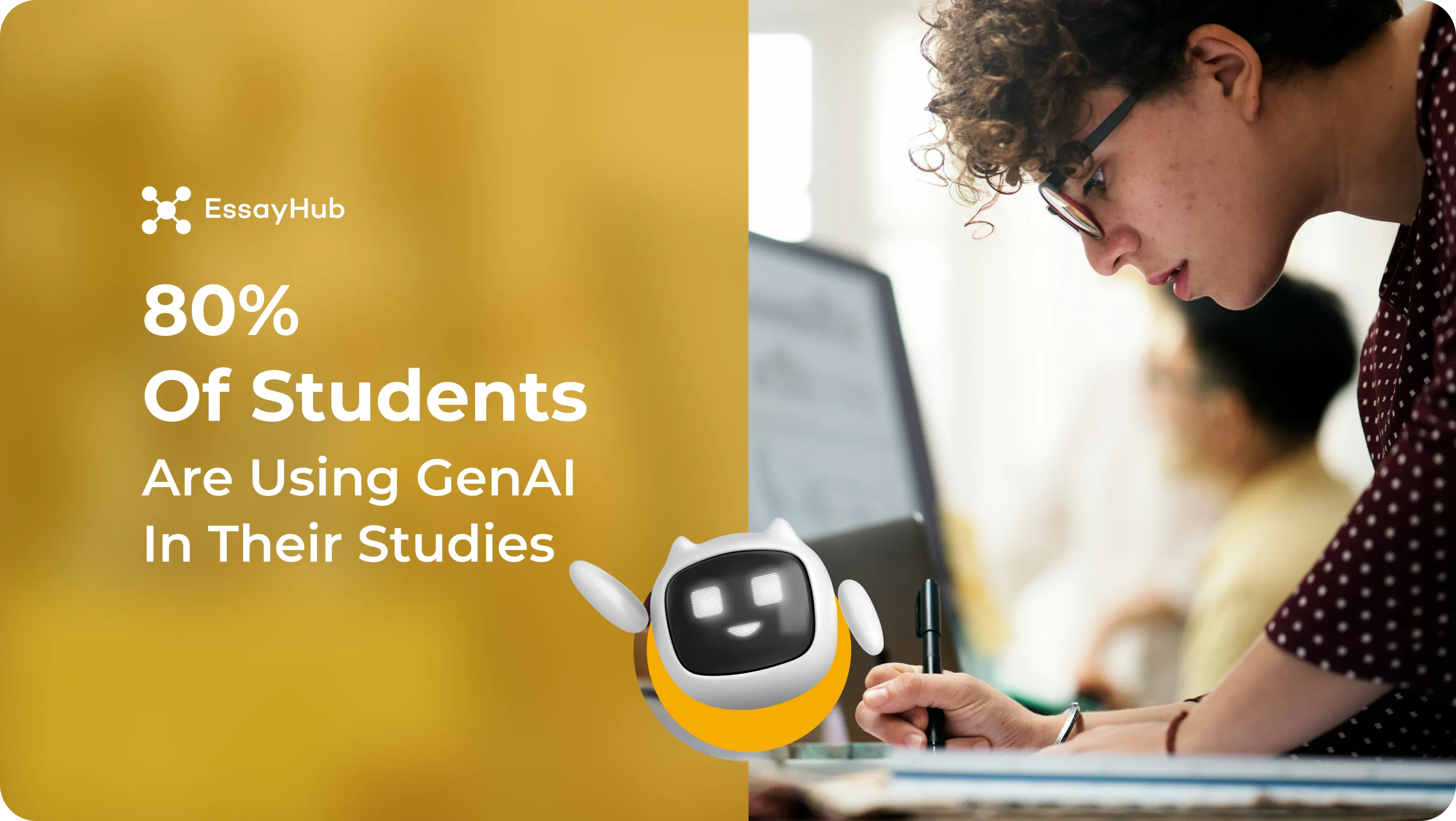Key Takeaways
- 80% of students surveyed now use GenAI, with daily use climbing above 50% and 90% saying their reliance has grown over the past year.
- On average, students juggle two AI tools, with ChatGPT leading for essays, Grammarly for grammar, and Gemini or Copilot for math and coding.
- The main benefits are speed, time, and quality: 55% learn faster, 41% save time, and 50% improve assignments with GenAI.
- Trust is a major concern: 38% worry about wrong answers, 45% about academic misconduct, and 33% face restrictions at their universities.
- 69% want universities to provide GenAI tools, especially in Saudi Arabia (88%), India (77%), and Kenya (76%), along with training on ethical use.
How EssayHub Conducted the Survey
To understand the rise of generative AI tools, it’s important to know who participated in this study and what methodologies were used.
The research combined three approaches: internal data analysis, desk research, and a structured survey. The survey was run on Prolific with 382 student respondents from the United States. To ensure relevance, the screener criteria required that all participants were active students already using AI chatbots in their studies. Responses came from students accessing the survey on mobile, tablet, and desktop devices, which helped capture a realistic view of different study habits.
GenAI Usage Trends Among Students
Generative AI has quickly become part of student learning. Surveys show that at least 80% of students worldwide report using large language models to support student learning, while some polls place adoption as high as 86%. This level of use demonstrates how central AI has become to study routines.
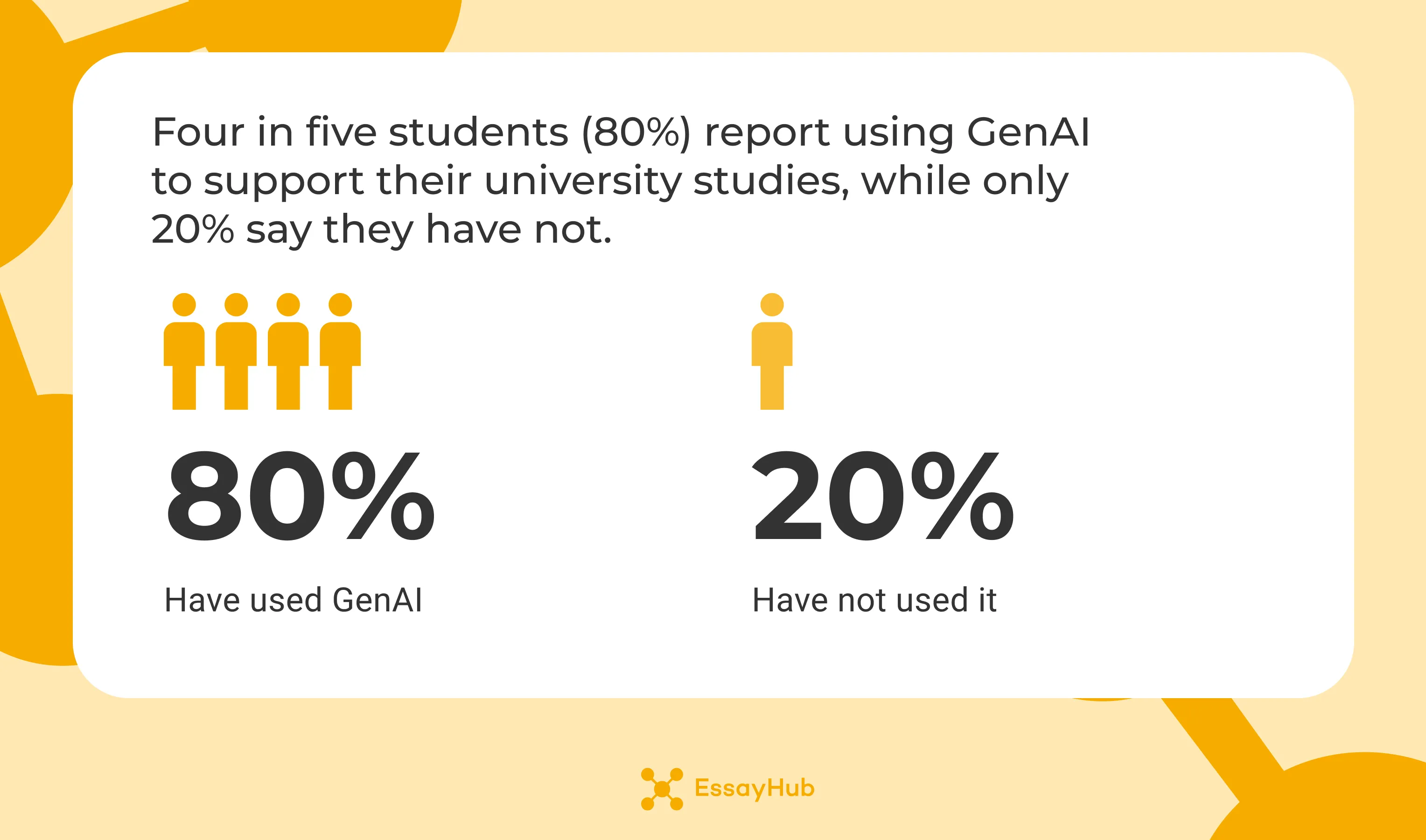
Key statistics from recent findings:
- 80–86% of students use GenAI for coursework or study support
- 50%+ engage with AI tools every day
- 95% of master’s and 97% of doctoral students report active use
- 2 tools on average are used regularly by each student
- 1 in 3 turn to AI first when facing assignment challenges
Compared with the usual sources of help, GenAI for students is starting to take the front seat. Almost a third of students say it’s the first thing they turn to when they’re stuck on an assignment, well ahead of textbooks, classmates, or even professors. Free resources and peer discussions are still popular, but AI has quickly become the go-to for fast explanations and a bit of extra guidance.
How Students Use GenAI and Which Tools They Choose
When students face challenges with assignments, almost 30% say they go to GenAI tools first, ahead of textbooks, professors, or peers. This shows how quickly AI has moved into the role of a primary support system for learning.
Generative AI for students is woven into almost every part of their academic work. The most common activity is grammar checking, reported by 58% of students, followed by writing essays and papers (42%) and summarizing long texts (39%).
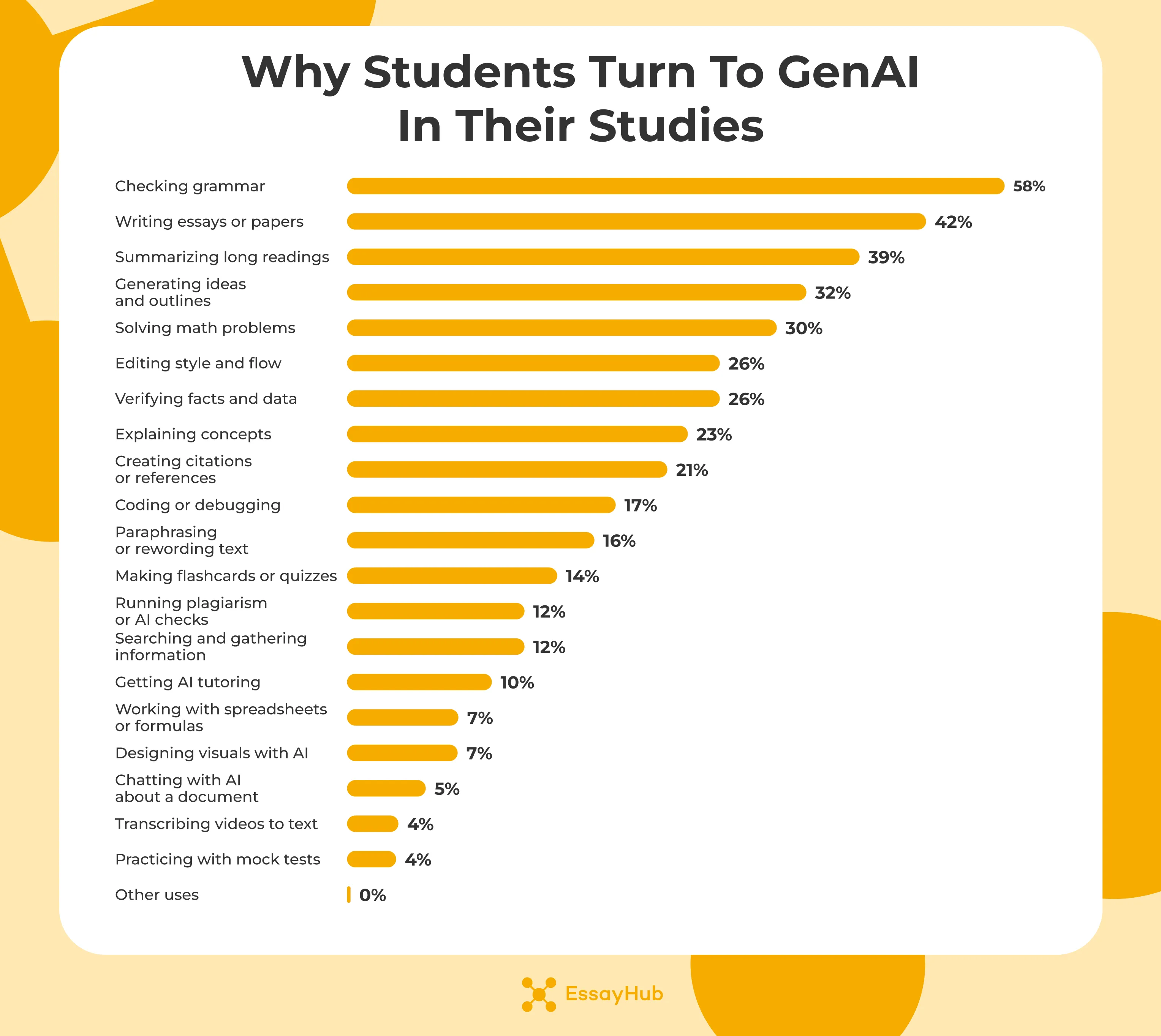
Different GenAI tools serve different purposes.
- ChatGPT: the most popular among the AI writing tools, used by the majority for essay writing, brainstorming ideas, and generating outlines.
- Grammarly: relied on by 58% of students for grammar, clarity, and tone adjustments.
- Gemini (Google): valued for both essay help and math problem solving.
- Copilot (Microsoft): popular for explaining complex concepts and handling math-related work.
- Claude (Anthropic): trusted by many for coding, logic-based queries, and structured writing tasks.
- QuillBot: used mainly for paraphrasing, rewriting, and polishing text.
For many, GenAI has become less of an optional add-on and more of a steady study companion.
What Students Gain from GenAI
Using GenAI brings clear benefits to student learning. For many students, the biggest gain is speed. More than half say it helps them pick up new ideas faster (55%), whether that means finally understanding a tough theory or cutting through a pile of notes the night before an exam. Time is another major win. About 41% feel that GenAI gives them hours back by handling the repetitive parts of academic work, leaving more space for the parts that actually require their focus.
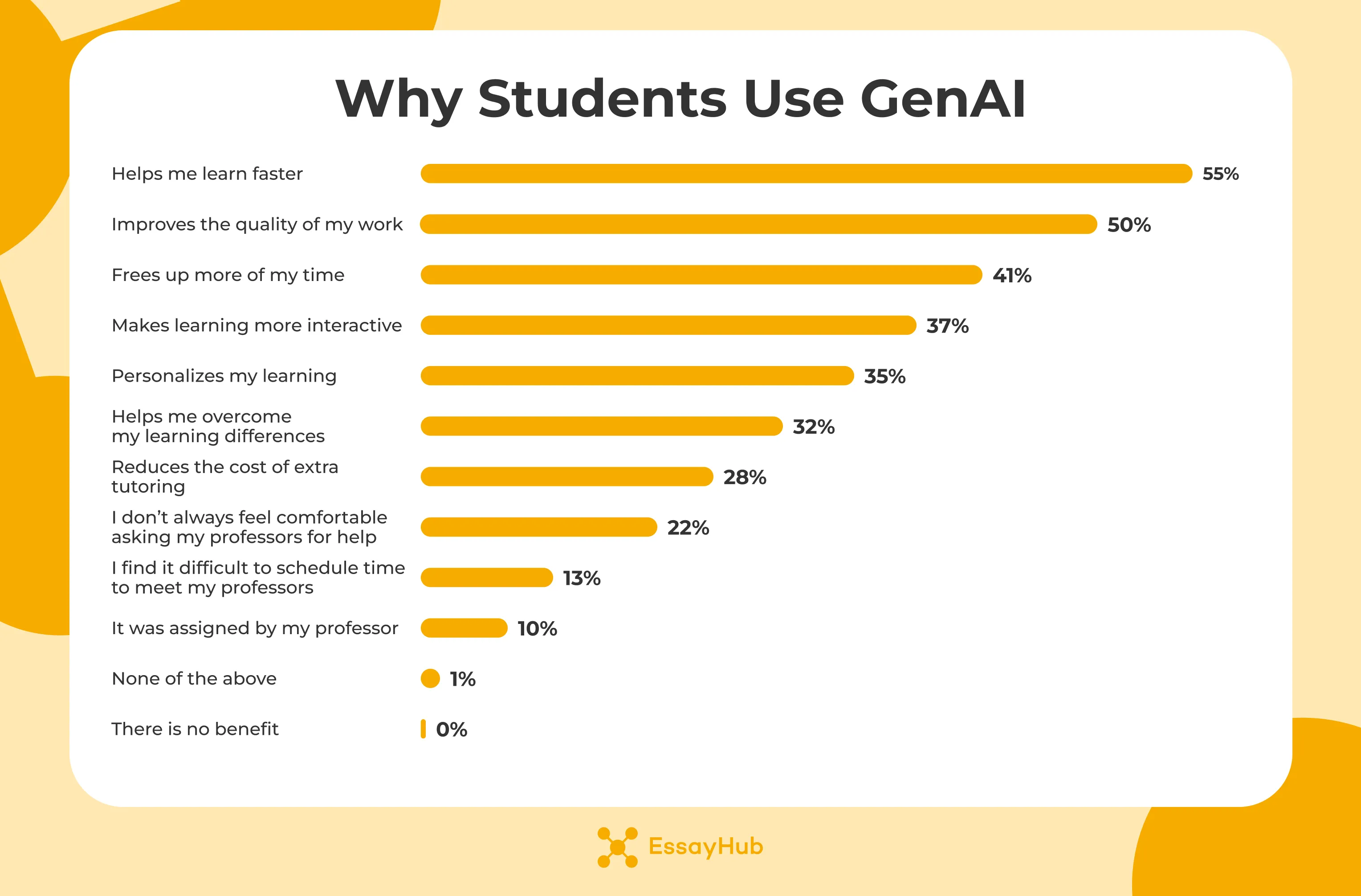
Beyond writing, the benefits of generative AI for students include having dense readings simplified, fresh ideas generated for projects, and academic support available when professors or a personal tutor aren’t. In practice, Generative artificial intelligence functions less as a backup tool and more as a reliable study partner that enhances both learning speed and output.
How Much Do Students Trust GenAI Tools?
Students may be quick to adopt GenAI, but trust lags behind enthusiasm. The numbers tell part of the story: 38% worry about inaccurate or misleading content, while 45% are concerned about being accused of academic misconduct if they rely too heavily on AI. On top of that, one in three students (33%) say their college or university already restricts the use of these tools.
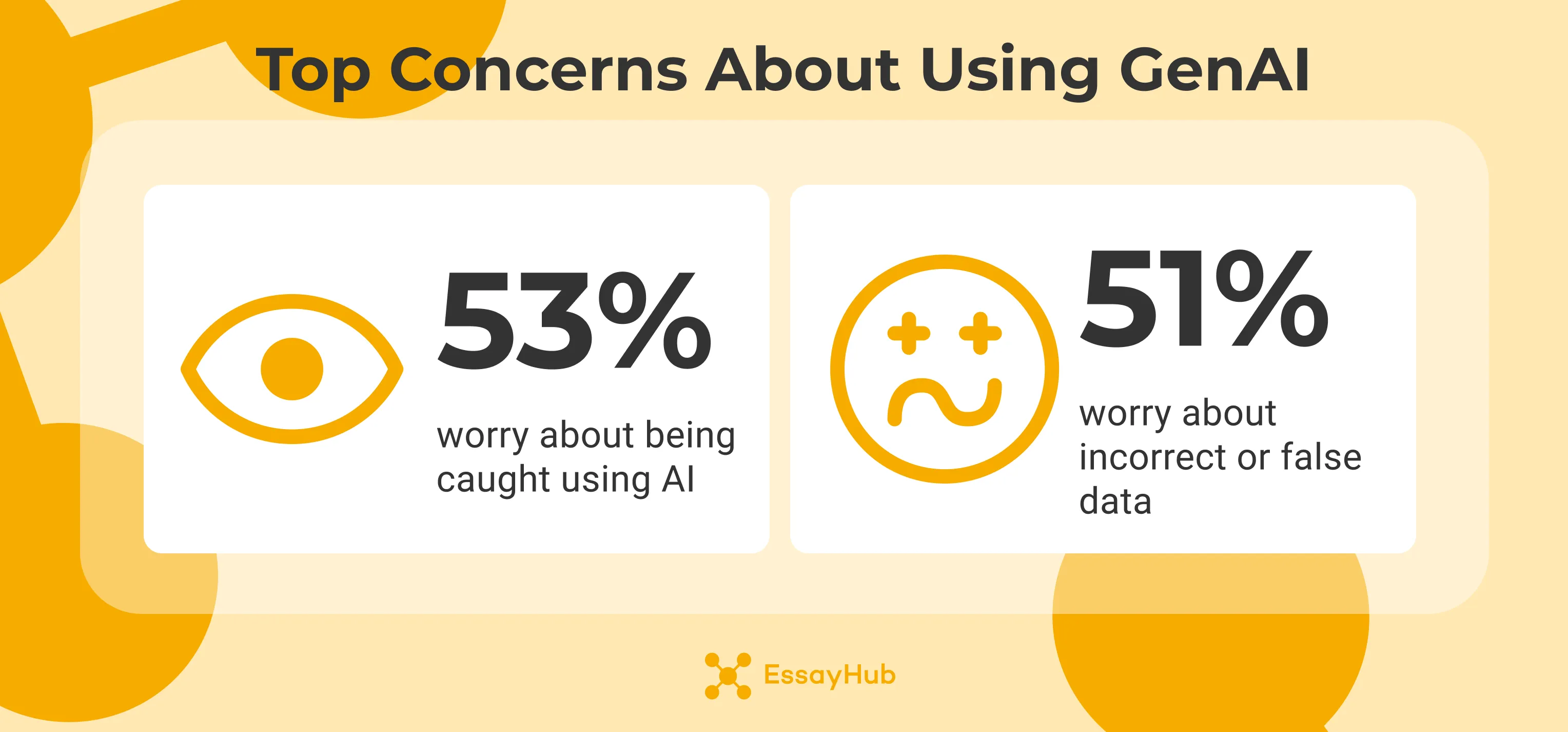
Beneath those statistics is a deeper issue: most GenAI platforms weren’t built with students in mind. They’re mass-market systems trained on sprawling datasets, designed to answer any question from anyone. That breadth is powerful, but it also means the answers can be shallow, biased, or simply wrong, which is a big risk in an environment where a single error in a paper can affect grades or credibility. When students talk about trust, they’re really talking about wanting GenAI tools that can distinguish between casual questions and academic rigor.
Students are looking for platforms that don’t just generate content but align with academic integrity policies and subject-specific accuracy. Imagine an AI that not only drafts an essay outline but flags which claims need citations, or one that can explain a math problem step by step rather than just spitting out the final answer.
How Students Expect Universities to Help with GenAI
Students are starting to look at their universities and asking for help. The survey shows that nearly seven in ten (69%) want their schools to provide a GenAI tool directly.
Share of students who want universities to provide GenAI tools:
- Saudi Arabia: 88%
- India: 77%
- Kenya: 76%
- United Kingdom: 60%
- Australia: 59%
What’s different now compared to just a year ago is how students think about artificial intelligence in the classroom. Before, most saw it as a personal shortcut or a private study trick. Today, more and more are saying: teach students how to use it properly. They want universities to include GenAI training in courses, show them how to spot errors in AI generated content, and explain what ethical use looks like. In other words, they want guidance on how GenAI can fit into their learning without putting their grades or academic integrity at risk.
But even with these expectations, students see obstacles that need fixing. Unequal access to AI tools, spotty online teaching and learning quality, and questions about data privacy all leave them cautious. The message is clear: giving students GenAI is only half the job; universities need to actually prepare students in AI literacy.
The Future of GenAI in Education
You can already see AI technologies inching closer to being something steadier, almost like a study partner that learns how you work and steps in before you even realize you need it.
The real shift will come with personalized learning. Think about how classes usually run: everyone trudges along at the same pace, whether they’re lost in the first chapter or bored by the third. GenAI will change that. If you’re stuck, it slows down. If you’re racing ahead, it doesn’t make you wait.
That could mean breaking education into smaller pieces, such as short lessons, quick quizzes, and interactive side paths that flex depending on how you move through them. And the more you use it, the sharper it gets at guessing what will help you next. It’s not hard to imagine a version of GenAI that works less like a search bar and more like a personal trainer.
However, these systems still make things up, sometimes with dangerous confidence. Biases sneak in too, shaping answers in ways most people won’t notice. And, of course, not every student will have the same chance to use it well. Access, training, and even just trust in the technology will split people apart unless schools figure out how to bridge that gap.
Wrapping It Up
GenAI is already a part of everyday student life. It saves time, explains things in a pinch, and helps polish work when deadlines are close. At the same time, students discuss bigger questions: can you really trust the output, and how should universities guide its use?
That’s why balance is important. AI can be a strong study companion, but students still need real guidance from people who know the academic world inside and out. That’s where EssayHub’s custom essay writing service fits in. We offer assistance that keeps learning grounded in integrity. Pairing tools like GenAI with trusted platforms like EssayHub gives students both speed and depth, a combination that sets them up not just to finish assignments, but to grow as thinkers.
FAQs
How Are Universities Reacting to Students Using GenAI?
Reactions are split. A growing number of schools are weaving GenAI literacy and ethics into their courses to teach students how to use it wisely. Others are leaning on restrictions and rules.
Why Do Some Students Still Avoid GenAI?
Trust is the biggest barrier. Some worry about wrong answers or being flagged for academic dishonesty. Others just prefer sticking to what feels familiar, like books, notes, or study groups they know they can count on.
Why Are GenAI Tools Popular Among Students?
Because it makes studying feel less heavy. Students say it helps them learn faster, polish their essays, and even break down tough readings into something manageable.
- Digital Education Council. (2024). Global AI student survey 2024. Digital Education Council. https://26556596.fs1.hubspotusercontent-eu1.net/hubfs/26556596/Digital%20Education%20Council%20Global%20AI%20Student%20Survey%202024.pdf
- University World News. (2025, February 21). AI use by students surges to 92%, second HEPI survey finds. University World News. https://www.universityworldnews.com/post.php
- Adams, R. (2025, February 26). UK universities warned to stress-test assessments as 92% of students use AI. The Guardian. https://www.theguardian.com/education/2025/feb/26/uk-universities-warned-to-stress-test-assessments-as-92-of-students-use-ai
- Institute for Teaching and Learning Innovation. (2025). Introducing AI and what students think about it. The University of Queensland. https://itali.uq.edu.au/teaching-guidance/ai-teacher-hub/introducing-ai-and-what-students-think-about-it

